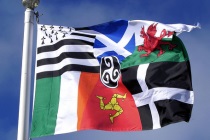The Cornish Language Takes Root
The number of “Cornish Speakers” is reported to be somewhere between 300 and 1500 depending on the source. The Cornish Language Board puts forward the number of 300 Cornish Speakers, according to the Guardian, who claim the language of the Celtic Nation to be their “primary tongue”. No matter, this language is taking root and beginning to thrive in what until very recently could only be described as a hostile environment.
The building blocks are surely in place for a comeback of the Celtic Tongue of the Cornish Nation. In April of last year Transceltic reported that in a culmination of the process dating back decades, the Cornish Language Partnership (MAGA) announced the finalization of the Standard Written Form of the Cornish language. Well that certainly was a stepping stone put place a mere 18 months ago.
This was followed by the thunderbolt from Whitehall. The Cornish were to join Scots, Welsh and Irish as officially recognized Celtic minorities within the confines of the United Kingdom. London’s decision was a victory for campaigners who had long dedicated themselves to the recognition of Cornwall as more than the motherland of the Pasty and Tin Mine Faeries but as a nation with its own ancient language and culture.
The standardization of the Cornish lexicon and recognition by the UK of the Cornish nation as an official minority has opened the flood gates of local initiatives to bring back the tongue.
This week the Cornish Council have made the following announcement: “ The Council’s draft Cornish Language Plan, which received £150,000 in government funding from the Department for Culture, Media and Sport, said staff should be encouraged to use “basic words and phrases” in Cornish when dealing with the public.”
In October of last year a conference was organized in partnership with Cornwall College, MAGA and the Institute for Cornish Studies to showcase Cornish language research. In February the Cornwall Branch of the Celtic League reported that the major British retailer Tesco is now using the Cornish tongue in retail transactions as well as flying Cornwall National Flag in front of their stores. Truro, Cornwall’s capital and a major urban centre in the southern and most Celtic portion of the Nation, moved to introduce bi-lingual signage at Truro Police station as reported by the Celtic League in February of this year. In September of this year the major retailer ASDA communicated that for the first time in ASDA’s history the store is having Cornish signage on customer entry and exit points at its new supermarket in Hayle.
The Cornish language is closely related to Welsh sharing approximately 65% of its vocabulary. Both languages are of the Brythonic branch of the Celtic tongue (Welsh, Breton and Cornish) versus that of the Goidelic (Irish, Scottish and Manx). According to Peter Beresford Ellis “Linguists argue that the form of Celtic we term Goidelic is the more archaic branch of Celtic. It is suggested that around the 7th century BC, the Celtic languages subdivided, when the form which we call Brythonic emerged. From a Goidelic parent, Brythonic modified and evolved in several ways.”
Given the breathtaking strides of the Welsh language under the guiding hand of the Welsh Language Commissioner Meri Huws, it is undeniable that the Cornish tongue will be carried forward by the surge in the renaissance of the Celtic tongue of SouthWest Britain.
![]()
http://www.theguardian.com/uk-news/2015/oct/07/cornwall-council-plans-to-encourage-staff-to-
http://www.transceltic.com/blog/cornish-revival-final-standard-written-form-cornish-tongue
http://www.dailymail.co.uk/news/article-2611599/Cornish-recognised-national-minority-group-time.html
http://www.transceltic.com/blog/breton-cornish-cultural-solidarity
- Emmett McIntyre's blog
- Log in to post comments






